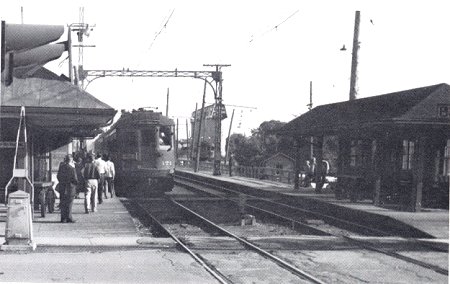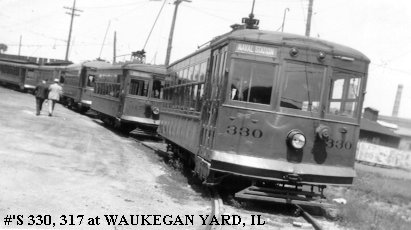 Edison Court Station in Waukegan. I lived ~200'
west of this station in 1992. Of course nothing remains. Picture- Waukegan
News Sun
Edison Court Station in Waukegan. I lived ~200'
west of this station in 1992. Of course nothing remains. Picture- Waukegan
News Sun
1920-1929
1920 opened a new passenger terminal at Adams and Wabash. This was an expensive and expansive terminal.
Early 1920's the NSL fleet of heavy steel car fleet doubled in size when 30 new interurbans from Cincinnati Car Company were ordered as part of an $800,000 order. Of these cars 15 were trailers and 15 were motorized able to go 80 m.p.h.
Mid-1920's saw the NSL operating 160 daily trains, including 44 daily Limited trains between Chicago and Milwaukee.
With the September 15, 1920 opening of 6th and Sycamore (now Michigan) in Milwaukee, came the Badger Limited. Travel time between Chicago and Milwaukee was 2 hours and 15 minutes with stops only in Racine and Kenosha.
1922 saw a new brick NSL station in Kenosha; (you can still have a meal in this remaining NSL station-it is an excellent italian restaurant). The main station included the ticket agency, waiting room, lunch counter, and parcel lockers. A secondary waiting room was built on the opposite side of the tracks for passenger convenience.
New structures were to replace frame buildings at Highland Park, Ravinia, Elm Street (Winnetka), and Indian Hill.
Another improvement for the Milwaukee division was changing over from a directly suspended trolley wire to a simple cantenary overhead construction. Concrete foundations were placed for installation of Bates expanded steel poles which were joined above trolley height by a similar expanded cross members to give a more rigid structure that with span lines.
In 1922, the NSL Line was experimentally equipped with radio equipment that was able to pick up grand opera broadcasts anywhere along the system. A few years later the NS installed phonographs on the parlor cars. Passengers could choose their musical selections.
August 12, 1922 saw the first NSL "motor coach" reach from Kenosha to Lake Geneva. Other routes such as Waukegan to Kenosha were added later. Schedules were closely coordinated with the rail service. At this period in time, the rubber tired vehicles were viewed a level above common rail travel. The NSL recognized this and therefore called their buses "motor coaches". They bought the most luxurious vehicles at that time.
The NSL believed in publicity- billboards, overhead bridge girders were a few places where one could see the advantage of taking the NSL next time. Well known Chicago artists were retained to design colored posters similar to those successfully used in the London "UndergrounD" subway.
A film called "The Green Bay Trail" was made by the NSL and it told a story of travel routes between Chicago and points in the North Shore district. It was shown in commercial movie theaters.
Another film called "The Pace of Progress" showed merchandise handling through recent history with emphasis on the Railway Dispatch Service.
The NSL also provided a monthly magazine for it's riders called the North Shore Line Bulletin. It first appeared in November, 1917.
In October 1923, the NSL won the first annual Charles A. Coffin Medal and Prize. Provided by the General Electric Company for the electric railroad who had done the most to popularize electric railway services.
1923 Waukegan and North Chicago Lines reached 4.3 million passengers annually. These Lines used the single-truck Birney "safety cars".
Also in the early 1920's the NSL began bus service to supplement their rail service in Waukegan and North Chicago. Service were also provided to towns of Lake Zurich and Antioch as well as Lake Geneva Wisconsin and others.
Early 1922 a train routinely left Milwaukee at 9:55a making a fast run to the LaSalle Street station downtown Chicago to make a prompt connection with the New York Central System 20th Century Limited. Southern Wisconsin businessmen were provided a link for cities on the east coast. This NSL train from Milwaukee was named the Eastern Limited and had it's own drumhead!
July 1923 saw the delivery of new luxury cars with observation platforms and drumhead signs for the Prairie State Special.
From 1915 to 1923 Insull's passenger traffic increased from less than one million to almost 7 million, and revenue went from 6 million to over 16 million dollars. He stressed safety, good labor relations and advertising.
At the time the area called the Skokie Valley was undeveloped. By 1923 all the necessary real estate had been acquired by a subsidiary established by the NSL called the Chicago North Shore and Northern Railroad. The south end of the route diverged from the existing line at the Howard Street "L" station, run west just north of Howard Street to connect with the Public Service Company of Northern Illinois right-of-way near Oakton and Cicero Avenue.
During 1924, the NSL offered stock to the general public and it's employees.
 Edison Court Station in Waukegan. I lived ~200'
west of this station in 1992. Of course nothing remains. Picture- Waukegan
News Sun
Edison Court Station in Waukegan. I lived ~200'
west of this station in 1992. Of course nothing remains. Picture- Waukegan
News Sun
The city of Evanston on April 2, 1924 passed the last ordinance permitting the construction for the new line. April 4, 1924 work began by L.E.Myers Company general contractors on one of the last interurban construction projects in the United States.
Materials for this section of the line were moved by 6 steam locomotives owned by the general contractor L.E. Myers Company.
1924 saw the beginning of the Skokie Valley cut off. This would lower travel time between Chicago and Milwaukee by over 20 minutes- opposed to the route closer to the lake due to less traffic. It was 23 miles from Niles Center to Libertyville branch. At height of the construction effort in the spring of 1926, 1500 men were working day and night to complete this project. A camp at Boldgett (now Briergate) consisted of 51 semi-permanent buildings with water and sewer systems, a bath house, mess halls, general store and a post office.
1925 the NSL dining cars were serving some 79,000 meals a year. Also in that year the North Shore exchanged trolley wire that was supported by wooden poles for compound cantenary system on steel bridges.
On March 28, 1925 the 4.9 mile section of the new Skokie Valley Route from it's southern most end at Howard Street in Chicago to Dempster in Niles Center was opened. From Dempster to South Upton the new line ran parallel to the Skokie freight line of the Chicago and Northwestern. At South Upton the new route left the joint right-of-way to run eastward along the Libertyville NS route and then connect with the existing west line at Lake Bluff. A half mile of the Libertyville Branch was realigned to give the new route the least possible curvature. The Skokie Valley Route was 13,337 feet longer than the main line- the Shore Line Route, but the faster speeds made the new line much improved.
On January 1, 1926 the contract with L. E. Myers Company was cancelled and all equipment, material, and personnel was turned over to the NSL and all work for that day on was done by NSL crews. June 1st was set as the new completion date.
The entire Skokie Valley Route from Dempster Street to South Upton was completed on time. These 18 miles of new double-track railways were built in about a year with the cost of $6,400,000 including right-of-way.
June 5, 1926 the Skokie Valley Route was opened (and 39 years later I was born)! Gross operating revenue for 1926 reached a new high of 7.6 million and the NSL transported a total of 19.5 million passengers. A figure that would not be exceeded for almost 20 years.
Every 1-3 miles along the new Skokie Valley Route, the NSL constructed a new spanish style looking stations. These 9 new stations and grounds were designed and landscaped so that the stations looked more like artistic bungalows rather than railroad stations.
The NSL also conducted a contest to name these new stations. Over 75,000 entries were received.
 Photo
courtesy of
Anthony Zeman
Photo
courtesy of
Anthony Zeman
On June 24, 1926 the 28th International Eucharistic Catholic Congress convened at Mundelein. The NSL had trains arrive every 40 seconds. By 10 a.m. approximately 130,000 people had arrived in Mundelein via the North Shore. From daybreak to midnight- 820 trains made up of 5,216 cars made the trip to and from Mundelein without a single mishap.
During 1926, automatic block signals were installed from North Chicago to Whinthrop Harbor and a year later extended to Wisconsin. By 1931 these Standard Automatic gates were installed at 34 crossings.
1926-1927 saw the color scheme of the NSL go to it's orange, maroon, green pattern due to safety considerations to make the cars more visible.
Beginning 1926 and 1927 the NSL began a pioneer "piggyback" operation then called "ferry truck service", between Milwaukee and Chicago's north side freight terminal at Montrose Avenue. This venue turned the money losing LCL department around.
Also in 1927, the NSL "motor coach" routes were passed on to the new Metropolitan Motor Coach Company in which the NSL retained a 45% interest.
In 1927, the North Shore began selling Pullman tickets to anywhere in the United States. The NS was one of the few interurbans granted this. Also in 1929, the North Shore began selling Stout Air Lines tickets. Again, one of the first interurbans to do this.
 Click on the ticket to return to
History Page
Click on the ticket to return to
History Page
 Click on the sign to return to NSL ticket
office
Click on the sign to return to NSL ticket
office
 Click on the NSL
Bulletin to go to next decade
Click on the NSL
Bulletin to go to next decade